Top Rankings
Minnesota Transitions Charter School District ranks among the top 20% of public school district in Minnesota for:
Category
Attribute
Diversity
Most diverse schools (Top 1%)
Community Size
Largest student body (number of students) (Top 1%)
For the 2025 school year, there are 9 public charter schools serving 4,943 students in Minnesota Transitions Charter School District. This district's average charter testing ranking is 5/10, which is in the bottom 50% of public charter schools in Minnesota.
Public Charter Schools in Minnesota Transitions Charter School District have an average math proficiency score of 17% (versus the Minnesota public charter school average of 31%), and reading proficiency score of 41% (versus the 42% statewide average).
Minority enrollment is 39% of the student body (majority Black), which is less than the Minnesota public charter school average of 65% (majority Black).
Overview
This School District
This State (MN)
# Schools
9 Schools
315 Schools
# Students
4,943 Students
69,887 Students
# Teachers
209 Teachers
4,947 Teachers
Student : Teacher Ratio
24:1
24:1
District Rank
Minnesota Transitions Charter School District, which is ranked within the bottom 50% of all 522 school districts in Minnesota (based off of combined math and reading proficiency testing data) for the 2021-2022 school year.
The school district's graduation rate of 61% has increased from 50% over five school years.
Overall District Rank
#418 out of 527 school districts
(Bottom 50%)
(Bottom 50%)

Math Test Scores (% Proficient)
17%
45%
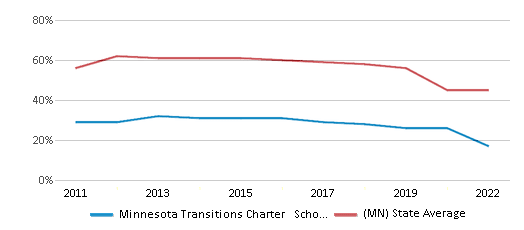
Reading/Language Arts Test Scores (% Proficient)
41%
51%
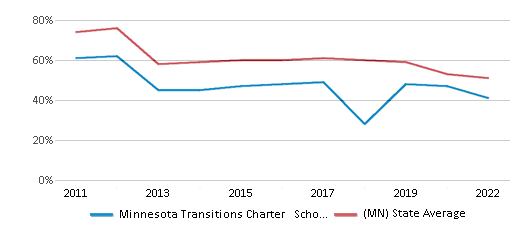
Science Test Scores (% Proficient)
28%
41%
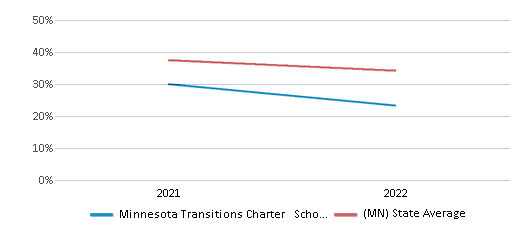
Graduation Rate
61%
84%
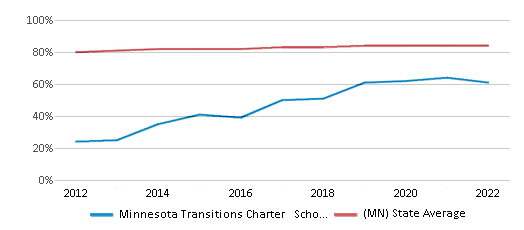
Students by Ethnicity:
Diversity Score
0.59
0.75
# American Indian Students
110 Students
1,090 Students
% American Indian Students
2%
1%
# Asian Students
85 Students
11,316 Students
% Asian Students
2%
16%
# Hispanic Students
464 Students
8,290 Students
% Hispanic Students
10%
12%
# Black Students
848 Students
21,467 Students
% Black Students
17%
31%
# White Students
3,020 Students
24,238 Students
% White Students
61%
35%
# Hawaiian Students
3 Students
42 Students
% Hawaiian Students
n/a
n/a
# Two or more races Students
413 Students
3,444 Students
% of Two or more races Students
8%
5%
Students by Grade:
# Students in PK Grade:
-
717
# Students in K Grade:
117
5,487
# Students in 1st Grade:
140
5,737
# Students in 2nd Grade:
152
5,943
# Students in 3rd Grade:
159
5,788
# Students in 4th Grade:
172
5,834
# Students in 5th Grade:
192
5,837
# Students in 6th Grade:
238
5,876
# Students in 7th Grade:
359
5,492
# Students in 8th Grade:
491
5,582
# Students in 9th Grade:
496
3,957
# Students in 10th Grade:
624
4,188
# Students in 11th Grade:
818
4,444
# Students in 12th Grade:
985
5,005
# Ungraded Students:
-
-
District Revenue and Spending
The revenue/student of $12,394 in this school district is less than the state median of $17,854. The school district revenue/student has grown by 11% over four school years.
The school district's spending/student of $12,748 is less than the state median of $18,580. The school district spending/student has grown by 11% over four school years.
Total Revenue
$61 MM
$15,547 MM
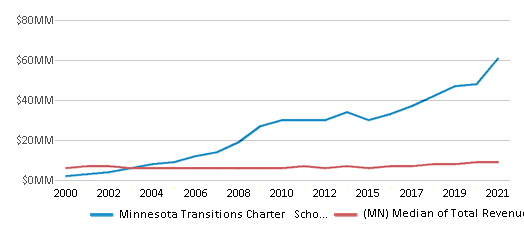
Spending
$63 MM
$16,179 MM
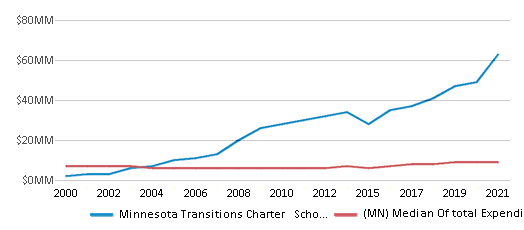
Revenue / Student
$12,394
$17,854
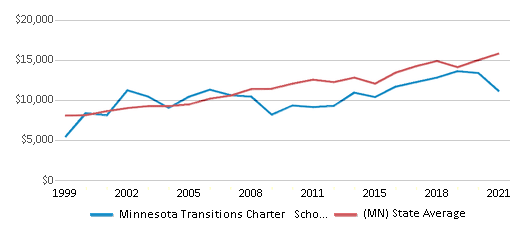
Spending / Student
$12,748
$18,580

Best Minnesota Transitions Charter School District Public Charter Schools (2025)
School
(Math and Reading Proficiency)
(Math and Reading Proficiency)
Location
Grades
Students
Rank: #11.
Minnesota Connections Academy K-6
Charter School
(Math: 22% | Reading: 44%)
Rank:
Rank:
3/
Bottom 50%10
1350 Energy Lane, Ste 230
Saint Paul, MN 55108
(651) 523-0888
Saint Paul, MN 55108
(651) 523-0888
Grades: K-6
| 911 students
Rank: #22.
Minnesota Connections Academy 7-12
Charter School
(Math: 16% | Reading: 48%)
Rank:
Rank:
3/
Bottom 50%10
1350 Energy Lane Suite 230
Saint Paul, MN 55108
(800) 382-6010
Saint Paul, MN 55108
(800) 382-6010
Grades: 7-12
| 3,021 students
Rank: #33.
Mts Pease Academy
Charter School
(Math: ≤20% | Reading: <50% )
Rank:
Rank:
3/
Bottom 50%10
601 13th Ave Se
Minneapolis, MN 55406
(612) 378-1377
Minneapolis, MN 55406
(612) 378-1377
Grades: 9-12
| 21 students
Rank: #44.
Banaadir Academy
Charter School
(Math: 10-14% | Reading: 30-34%)
Rank:
Rank:
2/
Bottom 50%10
1201 Bryant Ave N
Minneapolis, MN 55411
(612) 326-7200
Minneapolis, MN 55411
(612) 326-7200
Grades: 5-6
| 39 students
Rank: #55.
Banaadir Elementary School
Charter School
(Math: 15-19% | Reading: 20-24%)
Rank:
Rank:
1/
Bottom 50%10
1800 2nd St Ne
Minneapolis, MN 55418
(612) 724-4680
Minneapolis, MN 55418
(612) 724-4680
Grades: K-4
| 128 students
Rank: #66.
Minnesota Virtual Schools
Charter School
(Math: 10-14% | Reading: 25-29%)
Rank:
Rank:
1/
Bottom 50%10
1801 County Road B West Suite
Saint Paul, MN 55113
(651) 746-7977
Saint Paul, MN 55113
(651) 746-7977
Grades: 6-12
| 483 students
Rank: #77.
Mts High School
Charter School
(Math: ≤10% | Reading: 11-19%)
Rank:
Rank:
1/
Bottom 50%10
2872 26th Ave S
Minneapolis, MN 55406
(612) 722-9013
Minneapolis, MN 55406
(612) 722-9013
Grades: 7-12
| 139 students
Rank: #88.
Banaadir Secondary
Charter School
(Math: 6-9% | Reading: 15-19%)
Rank:
Rank:
1/
Bottom 50%10
1201 Bryant Ave N
Minneapolis, MN 55411
(612) 326-7200
Minneapolis, MN 55411
(612) 326-7200
Grades: 7-12
| 112 students
Rank: #99.
Minnesota Transitions Charter Elementary School
Charter School
(Math: 6-9% | Reading: 10-14%)
Rank:
Rank:
1/
Bottom 50%10
2526 27th Ave. South
Minneapolis, MN 55406
(612) 729-9140
Minneapolis, MN 55406
(612) 729-9140
Grades: K-6
| 89 students
Recent Articles

Year-Round Or Traditional Schedule?
Which is more appropriate for your child? A year-round attendance schedule or traditional schedule? We look at the pros and cons.

Why You Should Encourage Your Child to Join a Sports Team
Participating in team sports has a great many benefits for children, there is no doubt. In this article you will learn what those benefits are.

White Students are Now the Minority in U.S. Public Schools
Increasing birth rates among immigrant families from Asia and Central and South America, combined with lower birth rates among white families, means that for the first time in history, public school students in the United States are majority-minority. This shift in demographics poses difficulties for schools as they work to accommodate children of varying language abilities and socio-economic backgrounds.





